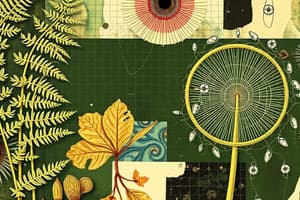Podcast
Questions and Answers
What is the primary function of a flower?
What is the primary function of a flower?
- To produce seeds or seed-bearing fruits (correct)
- To absorb water and nutrients
- To regulate temperature
- To provide structural support
What is the outer whorl of a flower composed of?
What is the outer whorl of a flower composed of?
- Stamen
- Petals
- Sepals (correct)
- Carpels
What is the female counterpart of the flower?
What is the female counterpart of the flower?
- Stamen
- Pistil
- Gynoecium (correct)
- Androecium
What is the function of the ovary in a flower?
What is the function of the ovary in a flower?
What is the term for a flower with only one carpel?
What is the term for a flower with only one carpel?
What is the term for flowers that have two or more merged carpels?
What is the term for flowers that have two or more merged carpels?
What is the location of the ovary in a flower?
What is the location of the ovary in a flower?
What is the term for an ovary that sits above the point of attachment of the petals, stamen, and sepals?
What is the term for an ovary that sits above the point of attachment of the petals, stamen, and sepals?
What is the purpose of the ovary in a flower?
What is the purpose of the ovary in a flower?
What is unique to the ovule of angiosperms?
What is unique to the ovule of angiosperms?
What occurs during the process of pollen formation in the anther?
What occurs during the process of pollen formation in the anther?
What is the function of the antipodal cells in the embryo sac?
What is the function of the antipodal cells in the embryo sac?
What is the purpose of the nectar guides in flowers?
What is the purpose of the nectar guides in flowers?
What is formed after fertilization of the two polar nuclei?
What is formed after fertilization of the two polar nuclei?
What is the taxonomical feature of angiosperms that determines the type of cotyledon developed?
What is the taxonomical feature of angiosperms that determines the type of cotyledon developed?
Flashcards are hidden until you start studying
Study Notes
The Structure and Function of a Flower
- A flower is a reproductive structure of angiosperms, the most diverse and complex plant species in the world.
- The primary function of a flower is to produce seeds or seed-bearing fruits.
- The main components of a flower, called whorls, are in four distinct parts: sepals, petals, androecium, and gynoecium.
The Ovary of a Flower
- The ovary is a part of a plant that functions as the structure where fertilization and seed development occur.
- The ovary is usually located at the base of the flower, below the stigma and style.
- One or more eggs, or ovules, are housed in the ovary.
- The arrangement of ovules varies among flower species.
Ovary Positions
- There are three types of ovary positions: hypogynous, perigynous, and epigynous.
- Hypogynous: the ovary sits above the attachment of the petals, stamen, and sepals (e.g., tulip, hibiscus).
- Perigynous: the petals, stamen, and sepals are attached at a mid-point (e.g., rose, peach).
- Epigynous: the ovary sits below the petals, stamen, and sepals (e.g., daffodil, squash).
Structure and Function of the Ovary
- The ovary is composed of a number of structures to ensure ovule development and the production of seed-bearing fruit.
- The ovary wall eventually develops into the pericarp in fruits (outer, protective covering).
- The locule is the compartment that houses the ovule.
- The ovule is connected to the placenta by the funiculus.
Placentation
- The arrangement of ovules in a flower is termed placentation.
- There are five types of placentation: parietal, free central, axile, basal, and marginal.
- Examples of each type of placentation include:
- Parietal: cucumber
- Free central: primrose
- Axile: lemon
- Basal: marigold
- Marginal: pea
Function of the Ovary
- The function of the ovary is to prepare the ovules for fertilization, protect developing zygotes, and develop into a seed-bearing fruit.
- The walls of the ovary grow and thicken after fertilization occurs and as seeds continue to develop.
Fruit Development
- The purpose of fruit development is an adaptation of angiosperms as a way to disperse seeds for the continuity of the species.
- Ripened fruit may develop from the ovary or other parts of the flower, such as the perianth.
- Examples of fruits include peppers, squash, nuts, wheat, and corn.
Ovule Functions
- The ovules of angiosperms function to produce a seed that remains dormant until germination outside the fruit.
- Unique to angiosperms, the ovule of a flower undergoes double fertilization.
Double Fertilization
- The process of double fertilization begins with pollen formation and embryo sac formation.
- The double fertilization steps include:
- Pollen attaches to the stigma, and a pollen tube descends into the ovary.
- Two sperm cells are formed and enter the embryo sac.
- One sperm cell fertilizes the egg, while the other fertilizes the two polar nuclei.
- The resulting zygote begins to divide, and the endosperm develops to provide nutrients for the zygote.
Petal Functions
- The beautiful petals of a flower serve to protect the style and stigma, but even more importantly, petals serve to help the pollination process.
- Petals attract pollinators in several ways, including:
- Perfume emanating from petals
- Color and patterns (called nectar guides)
- Ultraviolet light, which is visible to bees and provides a map toward the center of the flower.
Studying That Suits You
Use AI to generate personalized quizzes and flashcards to suit your learning preferences.




